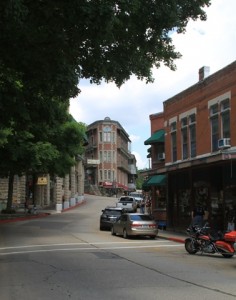
Eureka Springs, Arkansas. Photo © Carl & Peggy Backes.
The Fourth of July has come and gone—and whether you celebrated last weekend, this past weekend, or all week long—I hope that you had a fun-filled, memorable, and safe holiday. Of course, even though another summertime event has passed, there’s still plenty of time to enjoy America’s road trip season and, in keeping with my current blog series, visit a wide array of unique small towns.So far, in the first five parts of the series, I’ve described a dozen of my favorite small towns, all of which have less than 10,200 residents and offer a variety of diversions for travelers. In the fifth part, for instance, I listed three historic communities in the Midwest: Galena, Illinois; Lake Geneva, Wisconsin; and Petoskey, Michigan.
Now, in the sixth part, I’ve decided to explore three unique places across the American South:
I first encountered Eureka Springs as a child, during a road trip to Arkansas with my mom, and even back then, I fell in love with its quaint downtown area (pictured above) and Victorian-style architecture. So, it’s no surprise—to me, at least—that the entire town has been listed on the National Register of Historic Places as the Eureka Springs Historic District, making this lovely hamlet of roughly 2,100 residents an understandable favorite among history buffs. Nestled amid the Ozark Mountains, just south of the Missouri border, Eureka Springs and its environs offer a slew of other diversions, from hiking near the one-lane Beaver Bridge to browsing through various gift shops and art galleries. Anglers, meanwhile, can fish in lovely Black Bass Lake; canoeists might appreciate paddling down the Kings River; and visitors can also venture about 22 miles west to tour Pea Ridge National Military Park, where, in early March 1862, 26,000 soldiers fought in a pivotal Civil War battle to decide Missouri’s fate. Horseback-riding stables, biking rentals, golf courses, underground caves, recreational parks, live opera and theater, and day spas round out the experience here. For more information about Eureka Springs, including restaurants, accommodations, and live music venues, consult the Greater Eureka Springs Chamber of Commerce.
While it’s no secret, as evidenced in several of my previous posts, that New Orleans is my favorite U.S. city, the fact is that southern Louisiana features plenty of other worthwhile destinations, from Cajun Country to the Great River Road, and St. Francisville is one such place. Situated alongside the Mississippi River, north of Baton Rouge, this picturesque town of roughly 1,500 residents lures a variety of outdoor enthusiasts, including hikers, bicyclists, golfers, bird-watchers, and kayakers, but of course, many visitors come here to explore its past. Within the downtown historic district, for instance, you’ll find the West Feliciana Historical Society Museum, a restored hardware store featuring exhibits about the area’s history, such as the West Florida rebellion and John James Audubon’s time in the region. In fact, one popular attraction for history buffs is the Audubon State Historic Site, which encompasses the West Indies-style Oakley House, plus slave quarters, outbuildings, and herb gardens. Naturally, that’s not the only photogenic plantation in this area, which boasts the Butler Greenwood Plantation, a former indigo and cotton plantation that now offers bed-and-breakfast accommodations; the 371-acre Rosedown Plantation State Historic Site, which features a well-preserved mansion, several outbuildings, and impressive gardens; and The Myrtles Plantation, an antebellum home built in the 1790s and now considered one of the most haunted houses in America. As a bonus, you can even stay the night at Myrtles—if you dare. For more information about St. Francisville, consult Andrew Collins’ Moon New Orleans—or pick up a copy of my updated edition, which should be available by September.
As I’ve indicated in previous posts about South Padre Island, this breezy locale at the southern tip of Texas is ideal for winter getaways, treasure hunts, and other diversions. Outdoor enthusiasts especially favor this 30-mile-long island, only a sixth of which (on the southern end) is dedicated to the actual town. Besides exploring the windswept sand dunes north of the city limits, visitors can ride horses along the beach, courtesy of the Island Equestrian Center; swim and fish in the warm waters of the Gulf of Mexico and Laguna Madre; and encounter wild birds and dolphins through ecotourism operators like Fins to Feathers. In addition, visitors will find an assortment of day spas and worthy shops, peddling everything from surfboards to local artwork. Of course, South Padre also hosts a number of popular annual events, such as Sand Castle Days (which has unfortunately been postponed until next fall), and as with Eureka Springs and St. Francisville, the lodging and dining options here are varied, ranging from enormous hotels that cater to tourists to small eateries that are favored by locals. For more information about South Padre Island, consult Andy Rhodes’ Moon Texas.
So, as I’ve asked in my previous “small town” posts, have you ever visited any of these places? If so, do you agree with their inclusion on this list—and if not, why not?
In the meantime, stay tuned for the last part of my series, which will highlight three more of my favorite small towns, spread along the East Coast.